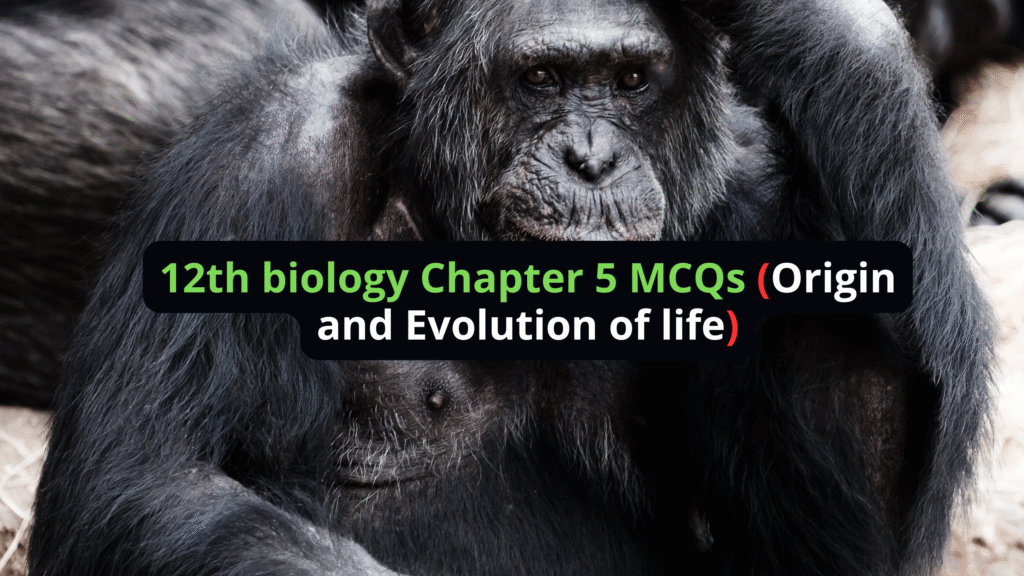12th biology Chapter 5 MCQs (Origin and Evolution of life)
Origin and Evolution of life, a critical chapter in Class 12 Biology, deals with DNA, RNA, genetic code, replication, and gene expression. To help you master this topic, we’ve compiled a rich collection of 12th biology Chapter 5 MCQs ( Origin and Evolution of life ) available as PDF downloads, online tests, and detailed answer keys. These resources are perfect for NEET, CBSE Class 12, and self-study revision.
Whether you’re a topper or a beginner, these 12th biology Chapter 5 MCQs ( Origin and Evolution of life ) are designed to strengthen your understanding and improve your exam performance.

12th biology Chapter 5 MCQs ( Origin and Evolution of life )
Q1. Who proposed that the first form of life could have come from per- existing non-living organic molecules?
a. Alfred Wallace
b. oparin and Haldane
c. Charles Darwin
d. Louis Pasteur
Answer: b. oparin and Haldane
Explanation: The theory of biogenesis was proposed by Oparin and Haldane. It states that life could have come from pre-existing non-living organic molecules (e.g. RNA, protein, etc.) and that the formation of life was preceded by chemical evolution, i.e. formation of diverse organic molecules from inorganic constituents.
Q2. In the Hardy – Weinberg equation, the frequency of homozygous recessive individuals is represented by…
a. P2
b. pq
c. q2
d. 2pq
Answer: c. q2
Explanation: To estimate the frequency of alleles in a population, we can use the Hardy-Weinberg equation. For a population in genetic equilibrium: p + q = 1.0 (The sum of the frequencies of both alleles is 100%.) q2 = frequency of aa (homozygous recessive)
Class 12 biology MCQ Chapterwise
Q3. Select the analogous organs-
a. Forelimbs of whale and bat
b. Flippers of dolphins and penguins
c. Thorn and tendrils of bougainvillea and cucurbita.
d. Vertebrates hearts or brains.
Answer: b. Flippers of dolphins and penguins
Explanation: Analogous organs are structures in different species that perform the same function but have evolved separately, thus do not share a common ancestor. The flippers of dolphins and penguins are analogous because both are adapted for swimming, but dolphins are mammals and penguins are birds.
Class 12 Chemistry MCQ Chapterwise
Q4. Archaeopteryx is known as the missing link because it is a fossil and shares characters of both-
a. Fishes and amphibians
b. Annelida and arthropods.
c. Birds and reptiles
d. Chordates and nonchordates
Answer: c
Explanation: Archaeopteryx is an iconic fossil, often thought of as the ‘missing link’ between birds and reptiles.
Q5. Identify the wrong statement regarding evolution.
a. Darwin’s variations are small and directional.
b. Mutations are random and non-directional.
c. Adaptive radiations lead to divergent evolution.
d. Mutations are non-random and directional.
Answer: d. Mutations are non-random and directional
Explanation: Mutations are indeed random and non-directional. They occur without regard to the needs of the organism. Darwin’s variations are small and directional, and adaptive radiations lead to divergent evolution, where species diverge from a common ancestor and adapt to different environments.
Q6. Gene frequency in a population remains constant due to –
a. Mutation
b. Migration
c. Random mating
d. Non-random mating
Answer: Random Mating
Explanation: There are a few factors such as gene migration (gene flow), genetic drift, mutation, genetic recombinations, natural selection, non-random mating, etc. which affect or change the Hardy-Weinberg equilibrium, If these factors do not occur in the population, that’s why gene frequency in a population is genetically stable or remain constant.
NEET Syllabus for Beginners: Complete Guide to NEET Syllabus
Q7. Which of the following characteristic is not shown by the ape?
a. Prognathous face
b. tail is present
c. Chin is absent
d. forelimbs are longer than hind limbs
Answer: b. Tail is present
Explanation: Apes, including gorillas, chimpanzees, orangutans, and gibbons, do not have tails. This is a distinguishing feature that separates them from other primates like monkeys, which do have tails. Apes have prognathous faces, lack chins, and their forelimbs are longer than their hind limbs.
Class 12 Biology Textbook Solutions Maharashtra Board
Q8. ……………… can be considered as a connecting link between ape and man.
a. Austalopithecus
b. Homo hablis
c. Homo erectus
d. Neanderthal man.
Answer: a. Australopithecus
Explanation: Australopithecus is considered a connecting link between apes and humans because it exhibits both ape-like and human-like characteristics. It had a smaller brain like an ape but walked upright like a human. Homo habilis, Homo erectus, and Neanderthal man are more closely related to modern humans.
Maharashtra Board Class 11 Biology Textbook Solutions
Q9. The Cranial capacity of Neanderthal man was
a. 600 cc
b. 940 cc
c. 1400 cc
d. 1600 cc
Answer: 1400 cc
Explanation: Neanderthals had a brain bigger than modern humans with an average of about 1400 cc, but lacked the complex belief systems and symbolic thinking unique to us.
